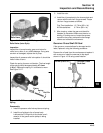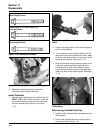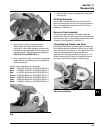
11.1
Section 11
Reassembly
11
Section 11
Reassembly
General
NOTE: Make sure the engine is assembled using all
specified torque values, tightening sequences
and clearances. Failure to observe
specifications could cause severe engine
wear or damage. Always use new gaskets.
Make sure all traces of any cleaner are removed
before the engine is assembled and placed into
operation. Even small amounts of these cleaners can
quickly break down the lubricating properties of engine
oil.
Check the closure plate, crankcase, cylinder heads,
and valve covers to be certain that all of the old RTV
has been removed. Use gasket remover, lacquer
thinner, or paint remover to remove any remaining
traces. Clean the surfaces with isopropyl alcohol,
acetone, lacquer thinner, or electrical contact cleaner.
Typical Reassembly Sequence
The following sequence is suggested for complete
engine reassembly. This procedure assumes that all
components are new or have been reconditioned, and
all component subassembly work has been completed.
The sequence may vary to accommodate options or
special equipment. Detailed procedures follow.
1. Install flywheel end oil seal.
2. Install governor cross shaft.
3. Install crankshaft.
4. Install connecting rods with pistons and rings.
5. Install camshaft.
6. Install closure plate assembly.
7. Install stator and backing plates.
8. Install flywheel.
9. Install fan and grass screen.
10. Install hydraulic lifters.
11. Install cylinder heads.
12. Install ignition modules.
13. Install intake manifold.
14. Install breather cover and inner baffles.
15. Install blower housing and outer baffles.
16. Install electric starter motor.
17. Install fuel pump.
18. Install carburetor.
19. Install external governor controls.
20. Install throttle and choke controls.
21. Install Oil Sentry
™
.
22. Install control panel (if so equipped).
23. Install valve covers.
24. Install air cleaner assembly (see Section 4).
25. Install muffler.
26. Install oil filter and add oil to crankcase.
27. Connect spark plug leads.
Install Flywheel End Oil Seal
1. Make sure that the seal bore of the crankcase is
clean and free of any nicks or burrs. See Figure
11-1.
CH18-745
Figure 11-1. Seal Bore of Crankcase.
2. Apply a light coat of clean engine oil to the outside
diameter of the oil seal.
3. Drive the oil seal into the crankcase using a seal
driver. Make sure the oil seal is installed straight
and true in the bore and that the tool bottoms
against the crankcase. See Figure 11-2.


















